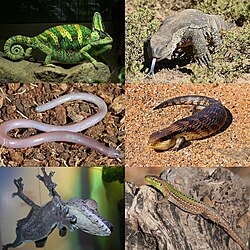| Lizards Temporal range: Middle Jurassic – Holocene, | |
|---|---|
 | |
| Clockwise from top left: veiled chameleon (Chamaeleo calyptratus), rock monitor (Varanus albigularis), common blue-tongued skink ( Tiliqua scincoides ), Italian wall lizard (Podarcis sicula), giant leaf-tailed gecko ( Uroplatus fimbriatus ), and legless lizard ( Anelytropsis papillosus ) | |
| Scientific classification | |
| Kingdom: | Animalia |
| Phylum: | Chordata |
| Class: | Reptilia |
| Order: | Squamata |
| Suborder: | Lacertilia |
| Groups included | |
 | |
| Range of the lizards, all species. | |
| Squamates that are not considered lizards | |
| |
Lizard is the common name used for all squamate reptiles other than snakes (and to a lesser extent amphisbaenians), encompassing over 7,000 species, [1] ranging across all continents except Antarctica, as well as most oceanic island chains. The grouping is paraphyletic as some lizards are more closely related to snakes than they are to other lizards. Lizards range in size from chameleons and geckos a few centimeters long to the 3-meter-long Komodo dragon.
Contents
- Anatomy
- Largest and smallest
- Distinguishing features
- Physiology
- Locomotion
- Senses
- Venom
- Respiration
- Reproduction and life cycle
- Aging
- Behaviour
- Diurnality and thermoregulation
- Territoriality
- Communication
- Defence
- Ecology
- Distribution and habitat
- Diet
- Antipredator adaptations
- Evolution
- Fossil history
- Phylogeny
- Taxonomy
- Convergence
- Relationship with humans
- Interactions and uses by humans
- In culture
- Notes
- References
- General sources
- Further reading
- External links
Most lizards are quadrupedal, running with a strong side-to-side motion. Some lineages (known as "legless lizards") have secondarily lost their legs, and have long snake-like bodies. Some lizards, such as the forest-dwelling Draco , are able to glide. They are often territorial, the males fighting off other males and signalling, often with bright colours, to attract mates and to intimidate rivals. Lizards are mainly carnivorous, often being sit-and-wait predators; many smaller species eat insects, while the Komodo eats mammals as big as water buffalo.
Lizards make use of a variety of antipredator adaptations, including venom, camouflage, reflex bleeding, and the ability to sacrifice and regrow their tails.


























